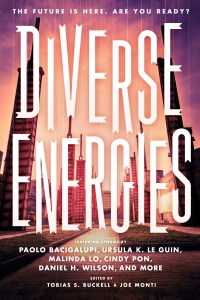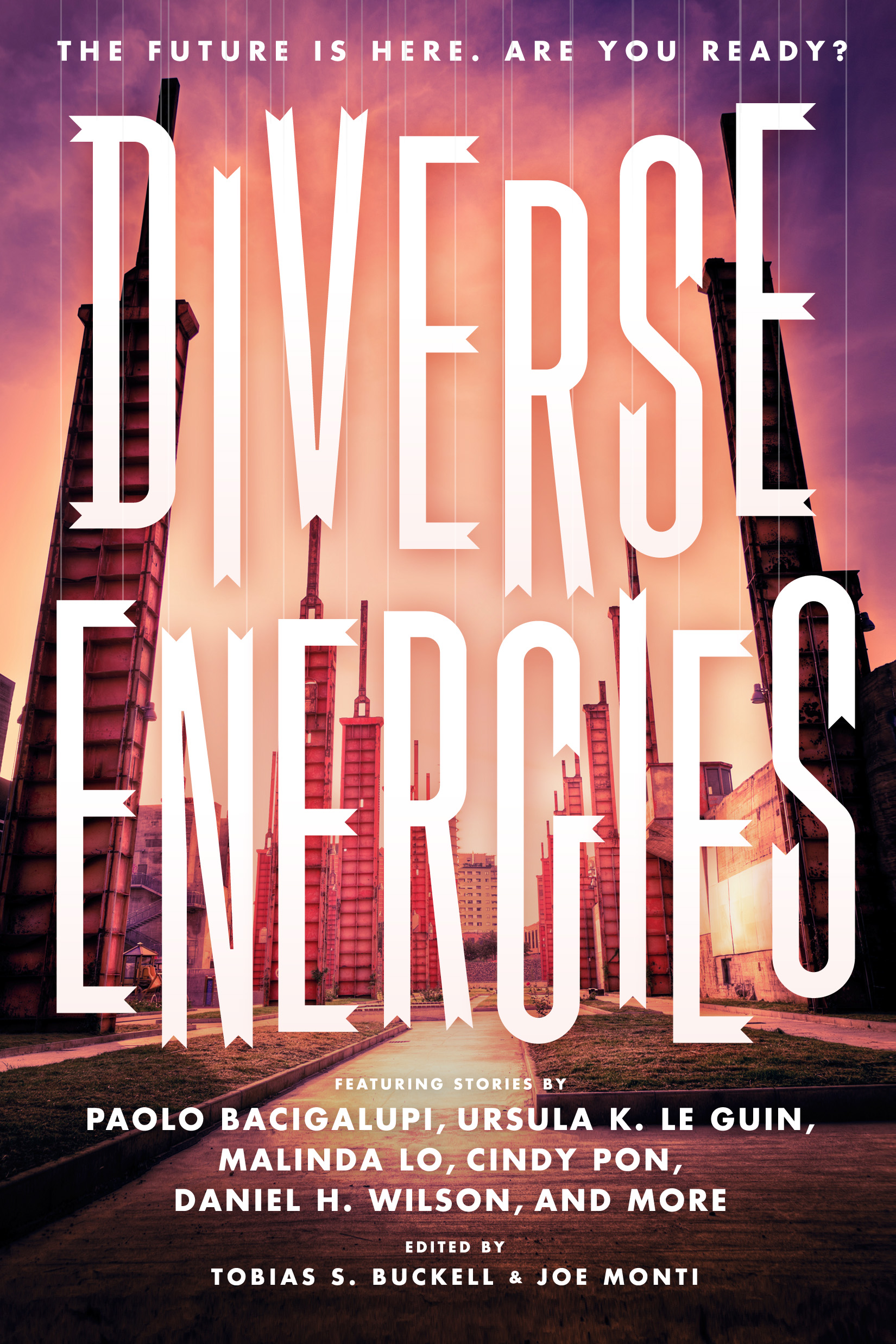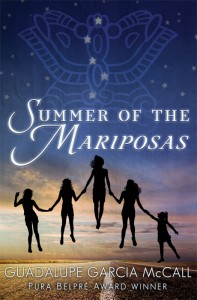Before Thanksgiving we had a great chat on Twitter with some of the contributing authors from our new dystopian anthology, Diverse Energies. Authors Cindy Pon, Malinda Lo, Ken Liu, Rahul Kanakia, Rajan Khanna, and K. Tempest Bradford joined us to answer some questions about their stories, dystopia, world-building, and more:
In one or two sentences, can you describe the dystopian worlds you’ve written about in Diverse Energies?

Malinda Lo: “The dystopian world in my story ‘Good Girl’ is a postapocalyptic NYC that politically resembles Communist China.”
Rahul Kanakia: “My story is set in a world where wealthy people have retreated into virtual reality and allowed the world to collapse. Also, there are pesticide-resistant bedbugs.”
Cindy Pon: “‘How had we drifted so far on what it meant to be human?‘ from my story sort of encapsulates it, in a world divided.”
Rajan Khanna: “Mine takes place in a world where an empire similar to the British Empire at its height uses child labor for mining.”
Ken Liu: “‘Pattern Recognition’ is about a school where children are safe. But only later do the children find out its real purpose.”
How did you decide on the specific settings where your stories take place?
Ken Liu: “My story took inspiration from a paper on human-powered computing & news about labor practices of Taiwanese manufacturers.”
Malinda Lo: “I wanted to write a story in a Big City that could be isolated in a disaster, and NYC fit well. As events have shown!”
Rajan Khanna: “I was inspired partly by a story about young kids in South Asia who ruin their bodies to make soccer balls.”
Cindy Pon: “The idea of setting it in Taipei came immediately. I was born there but left at age 6. So many memories are sensory based of Taipei. The city comes at all senses all the time.”
True or false: We are living in a dystopia.
Ken Liu: “I think far more of this planet’s population lives in a dystopia than most of us in the US are willing to acknowledge.”
Rajan Khanna: “I think from a teen standpoint, the world can often seem like a dystopia.”
K. Tempest Bradford: “Some people live in what others would see as a dystopia. It’s often a matter of perspective.”


Are oppressive governments a key part of dystopias?
Rajan Khanna: “For me, I associate that kind of oppression with dystopias. And I think that restriction of freedoms works as a YA theme.”
Malinda Lo: “My idea of ‘dystopian’ is firmly rooted in family stories/experience. I always think of oppressive governments first.”
Ken Liu: “I try to make my dystopias not about the government. I think other things are far more frightening than governments. . . . I think governments are often merely a symptom, not a cause. At least, not the cause.”
If not, are there elements that every dystopia needs?


Since these are short stories, any tips on how to build a world in very few pages?
Malinda Lo: “I think in short stories, world building must be done with some shorthand tricks. Can be hard. Shorthand tricks I like for worldbuilding in stories: food, names, twist on real-world setting that’s easily recognized. I cheated in the story by setting it in post-apoc NYC. Easy to “get”!”
Rahul Kanakia: “Most SF takes place in archetypical worlds: the Orwellian world; the gritty Blade Runner world, etc. The trick is knowing what mental image your reader starts the story with, and knowing how to deviate from that image. Most stories aren’t building worlds; they’re combining worlds that the readers have already ‘seen.’”
What is your favorite short story?
K. Tempest Bradford: “‘Even the Queen’ by Connie Willis. Far future story about menstruation (or lack thereof).”
Rajan Khanna: “‘There Will Come Soft Rains’ by Ray Bradbury.”
Rahul Kanakia: “Jorge Luis Borges’ ‘Library of Babel.’ Not sure the Diverse Energies readers will like it; when I made my students read it, they hated it. More apt example: ‘The Ones Who Walk Away From Omelas,’ by Le Guin.”
Malinda Lo: “Probably ‘The Bloody Chamber’ by Angela Carter.”
Cindy Pon: “Oh gosh. One of Stephen King’s I’m sure.”
You can read the whole chat on Storify.
Filed under:
BookTalk,
Musings & Ponderings,
Publishing 101 Tagged:
author advice,
diverse energies,
dystopia,
Science Fiction/Fantasy,
speculative fiction authors,
Teens/YA,
Tu Books 

How many times have I heard people call living on a farm or living in the past “simple”? Ursula K. Le Guin has a point here, in a quote from “Solitude,” her story in Diverse Energies:
Our daily life in the auntring was repetitive. On the ship, later, I learned that people who live in artificially complicated situations call such a life “simple.” I never knew anybody, anywhere I have been who found life simple. I think a life or a time looks simple when you leave out the details, the way a planet looks smooth, from orbit.
There’s more where that came from in the anthology! You can pre-order it now online (Amazon, Barnes & Noble) or look for it when it comes out in October.
Originally published at Stacy Whitman's Grimoire. You can comment here or there.
Now that it’s been circulating around for a while, I thought I’d show off the gorgeous Diverse Energies cover right here, in case you missed it in the hundred other places people are talking about it. In other news, I haven’t had much time for blogging lately, but I am working hard on Awakening by Karen Sandler (Tankborn 2) and New Worlds by Shana Mlawski (spring books) as well as books for next fall that include Joseph Bruchac’s next book. Here’s the description we sent to Publisher’s Marketplace:
Stacy Whitman at Lee & Low Books has bought world rights for Wolf Mark author Joseph Bruchac’s newest YA Killer of Enemies, a post-apocalyptic science fiction novel with a steampunk twist, for publication in fall 2013 under the Tu Books imprint. Described as “space cowboys in the new Old West,” it retells the story of Lozen, the monster slayer of Apache legend, in a world where space dust has rendered digital technology obsolete. Barbara S. Kouts of the Barbara S. Kouts Agency did the deal.
Awesome, right? I’m SO EXCITED for it, you guys. And, without further ado, check out this gorgeousness from designer Ben Mautner. And the lineup? If you haven’t seen it yet, check it out after the cover.

No one can doubt that the wave of the future is not the conquest of the world by a single dogmatic creed but the liberation of the diverse energies of free nations and free men. No one can doubt that cooperation in the pursuit of knowledge must lead to freedom of the mind and freedom of the soul.
—President John F. Kennedy, from a speech at University of California, March 23, 1962
In a world gone wrong, heroes and villains are not always easy to distinguish and every individual has the ability to contribute something powerful.
In this stunning collection of original and rediscovered stories of tragedy and hope, the stars are a diverse group of students, street kids, good girls, kidnappers, and child laborers pitted against their environments, their governments, differing cultures, and sometimes one another as they seek answers in their dystopian worlds. Take a journey through time from a nuclear nightmare of the past to society’s far future beyond Earth with these eleven stories by masters of speculative fiction. Includes stories by Paolo Bacigalupi, K. Tempest Bradford, Rahul Kanakia, Rajan Khanna, Ursula K. Le Guin, Ken Liu, Malinda Lo, Ellen Oh, Cindy Pon, Greg Van Eekhout, and Daniel H. Wilson. Edited by Tobias Buckell and Joe Monti.
Originally published at Stacy Whitman's Grimoire. You can comment here or there.
Will you be at ALA in Anaheim? So will Guadalupe Garcia McCall, author of Summer of the Mariposas!  Guadalupe will be there to celebrate her first book, Under the Mesquite, and its win of the Pura Belpre Author Award, but she’ll also be signing ARCs of Mariposas, so be sure to come by the booth. You can find the schedule on the Lee & Low blog.
Guadalupe will be there to celebrate her first book, Under the Mesquite, and its win of the Pura Belpre Author Award, but she’ll also be signing ARCs of Mariposas, so be sure to come by the booth. You can find the schedule on the Lee & Low blog.
Several of the contributors to Diverse Energies will also be at ALA, and though they don’t have a specific signing time, they will be dropping in to sign select copies of the book. Perhaps you might be the lucky one to win a copy in a drawing. And if you just want to read some awesome stories, signed or not, from Ursula K. Le Guin, Paolo Bacigalupi, Daniel H. Wilson, Cindy Pon, Malinda Lo, Greg van Eekhout, and more, make sure to stop by and take a look.
And whether or not you’re off to California this weekend, if you’re a reviewer or a librarian and on NetGalley (and if you’re one of those and NOT on NetGalley, check it out) our fall books are now available for you to request for review. Take a look!
Originally published at Stacy Whitman's Grimoire. You can comment here or there.
…is about to crack wide open thanks to some REALLY good news I’ve read from a recent press release – sent to me from my friend and author, Cindy Pon.

Author Cindy Pon
| By Press Release |
March 29, 2012 |
|
A press release from Hannah Ehrlich of Lee & Low Books: |
Tu Books, a new imprint of Lee & Low Books that publishes diverse science fiction and fantasy for young readers, has announced the upcoming publication of Diverse Energies, a YA anthology of dystopian stories edited by author Tobias S. Buckell and literary agent Joe Monti. The anthology, which will be released in Fall 2012, will feature stories by several award-winning speculative fiction writers including Ursula K. Le Guin, Paolo Bacigalupi, Malinda Lo, Cindy Pon, and Greg van Eekhout.
The stories in Diverse Energies journey through many alternate histories and projections of the future, but all have one important element in common: the inclusion of people of color. At a time when some fans have criticized The Hunger Games for casting African American actors to play Rue, Thresh, and Cinna, it is more important than ever that science fiction and fantasy worlds include a truly diverse cast of characters.
“So often the future looks whitewashed in YA dystopias,” says Tu Books Editorial Director Stacy Whitman. “In general many authors, including Tobias, feel that there is a gap in which people of color looking for depictions of themselves in the future can’t find them, especially young readers. These outstanding stories show that even in a dystopian future, people of color have a place.”
Stories include Paolo Bacigalupi’s “A Pocketful of Dharma,” about a young boy in a futuristic China whose encounter with a Tibetan conspiracy changes his life. Malinda Lo’s “Good Girl” is about a girl searching for her brother in what they think is the last city on earth, a doomed, tightly controlled New York City. “It’s about manipulation and loss and the hope of possibilities,” says Whitman. Meanwhile, Ellen Oh’s “The Last Day” takes a second look at history and considers what might have happened had Nagasaki and Hiroshima not ended the Pacific Theater of World War II.
The title Diverse Energies comes from a quotation from John F. Kennedy that both Buckell and Monti felt encapsulated their desire for greater diversity in fantasy and YA: “No one can doubt that the wave of the future is not the conquest of the world by a single dogmatic creed but the liberation of the diverse energies of free nations and free men.”
“I hope Diverse Energies sends the message that multiculturalism is the future, and a strength,” says Buckell.











